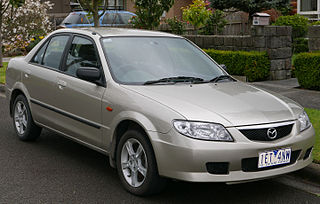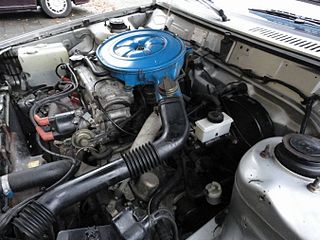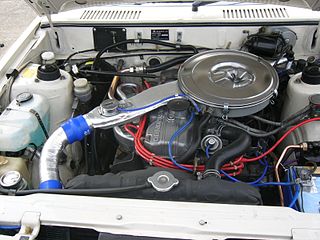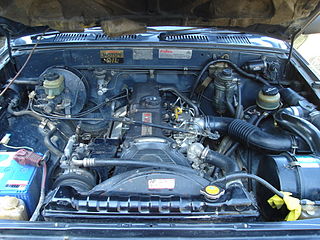
The Ford Laser is a compact car, originally a subcompact car in the first three generations, which was sold by Ford in Asia, Oceania, and parts of South America and Africa. It has generally been available as a sedan or hatchback, although convertible, wagon and pick-up versions have also been available in different markets. The sedan, and briefly station wagon, versions were badged Ford Meteor in Australia between 1981 and 1987. The Ford Meteor name was also used in South Africa.

The Mazda Luce is an executive car that was produced by Mazda in Japan from 1966 until 1991. It was widely exported as the Mazda 929 from 1973 to 1991 as Mazda's largest sedan. Later generations were installed with luxury items and interiors as the Luce became the flagship offering. The Luce was replaced by the Sentia in 1991 which was also exported under the 929 nameplate.

The Mazda Familia, also marketed prominently as the Mazda 323, Mazda Protegé and Mazda Allegro, is a small family car that was manufactured by Mazda between 1963 and 2003. The Familia line was replaced by the Mazda3/Axela for 2004.

The Ford Pinto engine was the unofficial but generic nickname for a four-cylinder internal combustion engine built by Ford Europe. In Ford sales literature, it was referred to as the EAO or OHC engine and because it was designed to the metric system, it was sometimes called the "metric engine". The internal Ford codename for the unit was the T88-series engine. European Ford service literature refers to it as the Taunus In-Line engine. In North America it was known as the Lima In-Line (LL), or simply the Lima engine due to it being manufactured at Lima Engine in Lima, Ohio.

The Ford Essex V6 engine is a 60° V6 engine built between 1966 and 1988 by the Ford Motor Company in the United Kingdom and until 2000 in South Africa although mostly in the Ford engine plant of Dagenham, Essex, which gave the engine its name. It is closely related to the Ford Essex V4 engine produced in displacements of 1.7 L and 2.0 L. Both engines share many parts since the Essex V6 was directly derived from the Essex V4; the 2.0 L Essex V4 and the 3.0 L Essex V6 in fact have exactly the same bore and stroke and share various components.

The F engine family from Mazda is a mid-sized inline-four piston engine with iron block, alloy head and belt-driven SOHC and DOHC configurations. Introduced in 1983 as the 1.6-litre F6, this engine was found in the Mazda B-Series truck and Mazda G platform models such as Mazda 626/Capella as well as many other models internationally including Mazda Bongo and Ford Freda clone, Mazda B-series based Ford Courier, Mazda 929 HC and the GD platform-based Ford Probe
The Mazda B-series engine - not to be confused with the Mazda B-Series truck - is a small-sized, iron-block, inline four-cylinder with belt-driven SOHC and DOHC valvetrain ranging in displacement from 1.1 to 1.8 litres. It was used from front-wheel drive economy applications to the turbocharged full-time 4WD 323 GTX and rear-wheel drive Miata as well as numerous other models. The Mazda B-series is a "non-interference" design, meaning that breakage of its timing belt does not result in damage to valves or pistons, because the opening of the valves, the depth of the combustion chamber and the shaping of the piston crown allow sufficient clearance for the open valves in any possible piston position.
After an early flirtation with V-twin engines, Mazda's small cars of the 1960s were powered by OHV straight-2 and straight-4 engines. This family lasted from 1961 until the mid-1970s. Today, Mazda's keicars use Suzuki engines. It was produced at the Hiroshima Plant in Hiroshima, Japan.
The C family was Mazda's first large piston engine design. It is not certain whether Mazda has a name for this collection of engines, and it is uncertain precisely which ones are related.

The Mazda K-series automobile engine is a short stroke 60° 24-valve V6 with belt-driven DOHC and all-aluminium construction. Displacements range from 1.8 L to 2.5 L. They all use a 27-degree DOHC valvetrain with directly actuated hydraulic bucket lifters. The K-series also features a highly rigid aluminum split-crankcase engine block design with 4-bolt mains with additional bolts securing the lower block, an internally balanced forged steel crankshaft with lightweight powder forged carbon steel connecting rods. They were designed with the intent of being as compact as possible for short-hood front-wheel drive applications.

Mazda has a long history of building its own diesel engines, with the exception of a few units that were built under license.

The Nissan SR engine is a 1.6 L (1,596 cc), 1.8 L (1,838 cc) or 2.0 L (1,998 cc) straight-four, four-stroke gasoline internal combustion engine manufactured by Nissan Motors. It has an aluminum head and block with steel sleeves and has a DOHC 4-valve design, with variable valve timing on select models. The engine was used in many small to medium Nissan vehicles including high-performance turbocharged variants. It was designed by Nissan as a replacement for the earlier CA series of engines. Power output shown is JIS Net PS or ECE Net kilowatts unless otherwise indicated.

The Mitsubishi Astron or 4G5/4D5 engine, is a series of straight-four internal combustion engines first built by Mitsubishi Motors in 1972. Engine displacement ranged from 1.8 to 2.6 litres, making it one of the largest four-cylinder engines of its time.

The E-series was a line of inline four-cylinder automobile engines designed and built by Honda for use in their cars in the 1970s and 1980s. These engines were notable for the use of CVCC technology, introduced in the ED1 engine in the 1975 Civic, which met 1970s emissions standards without using a catalytic converter.

The Suzuki G engine is a series of three- and four-cylinder internal combustion engines manufactured by Suzuki Motor Corporation for various automobiles, primarily based on the GM M platform, as well as many small trucks such as the Suzuki Samurai and Suzuki Vitara and their derivatives.

The L family is a family of inline four-cylinder diesel engines manufactured by Toyota, which first appeared in October 1977. It is the first diesel engine from Toyota to use a rubber timing belt in conjunction with a SOHC head. Some engines like the 2L-II and the 2L-T are still in production to the present day. As of August 2020, the 5L-E engine is still used in Gibraltar in the fifth-generation Toyota HiAce, eighth-generation Toyota Hilux, second-generation Toyota Fortuner, and fourth-generation Toyota Land Cruiser Prado. Vehicles with the diesel engine were exclusive to Toyota Japan dealership locations called Toyota Diesel Store until that sales channel was disbanded in 1988.

The Mitsubishi 3G8 engine is a range of three-cylinder powerplant from Mitsubishi Motors, introduced in the fifth generation of their Mitsubishi Minica kei car. In common with other contemporary engines in the class, it could be specified with many advanced technologies despite its diminutive size, including multi-valve cylinder heads and double overhead camshafts. The top-of-the-line Dangan ZZ variant was also the first kei car to benefit from turbocharging. In 1987 Mitsubishi was the first manufacturer to supercharge a kei vehicle, and in 1989 became the world's first production car to feature five valves per cylinder, ahead of similar developments by Bugatti, Audi, Ferrari and Toyota.
The ToyotaC engine family was a series of inline-4 diesel engines. There were two earlier generations of an engine Toyota named as the "Type C". The first generation was introduced in 1940 as a modification of the Type A engine. This first "Type C" was installed in the Toyota AE. The second generation was the first diesel engine at 1500cc used in the CS20 series 1959 Toyota Crown in October 1959. Japanese market vehicles with diesel engines were exclusive to Toyota Japan dealerships called Toyota Diesel Shop locations from 1979 until the dealership was cancelled in 1988.

The Mazda L-series is a mid-sized inline 4-cylinder gasoline piston engine designed by Mazda as part of their MZR family, ranging in displacement from 1.8L to 2.5L. Introduced in 2001, it is the evolution of the cast-iron block F-engine. The L-series is used by Ford as their 1.8L to 2.5L Duratec world engine.

The Suzuki K engine family is a series of all aluminium inline-three or four cylinder automobile engines from Suzuki, introduced in 1994. The displacement is ranging from 0.7 L to 1.5 L. This is a timing chain head driven DOHC 4-valve per cylinder engine with VVT, using multipoint fuel injection or direct injection fuel system, turbocharged for some variants and also available with hybrid electric technology.
















